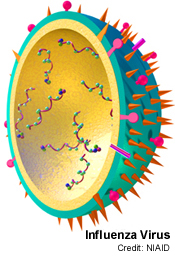Influenza: Difference between revisions
No edit summary |
No edit summary |
||
| Line 5: | Line 5: | ||
</div> | </div> | ||
== Introduction == | == Introduction == | ||
[[File:Influenza virus.jpg|right|frameless]] | |||
Influenza is a communicable viral disease that affects the upper and lower respiratory tract. A wide spectrum of influenza viruses causes it. Some of these viruses can infect humans, and some are specific to different species. | Influenza is a communicable viral disease that affects the upper and lower respiratory tract. A wide spectrum of influenza viruses causes it. Some of these viruses can infect humans, and some are specific to different species. | ||
| Line 18: | Line 19: | ||
* Cough | * Cough | ||
* Sore throat. | * Sore throat. | ||
Influenza spreads rapidly and efficiently in seasonal epidemics. Flu epidemics occur every autumn and winter in temperate regions and affect a significant portion of adults and children, but seasons differently impact age groups and severity<ref>Boktor SW, Hafner JW. [https://www.ncbi.nlm.nih.gov/books/NBK459363/ Influenza] [Internet]. StatPearls.21.11.2020 Available from:https://www.ncbi.nlm.nih.gov/books/NBK459363/ (last accessed 7.12.2020)</ref> | Influenza spreads rapidly and efficiently in seasonal epidemics. Flu epidemics occur every autumn and winter in temperate regions and affect a significant portion of adults and children, but seasons differently impact age groups and severity<ref name=":0">Boktor SW, Hafner JW. [https://www.ncbi.nlm.nih.gov/books/NBK459363/ Influenza] [Internet]. StatPearls.21.11.2020 Available from:https://www.ncbi.nlm.nih.gov/books/NBK459363/ (last accessed 7.12.2020)</ref> | ||
== | == Etiology == | ||
There are four types of influenza viruses, A, B, C, and D. Influenza viruses have receptors responsible for making them species-specific. | |||
Influenza types A and B cause human infection annually during the epidemic season. There are many different strains and they can change every year.<ref name=":1">Australian Govt. [https://www.health.gov.au/health-topics/flu-influenza Flu] Available from;https://www.health.gov.au/health-topics/flu-influenza (last accessed 7.12.2020)</ref> | |||
Influenza A | |||
* Has several subtypes according to the combination of hemagglutinin (H) and the neuraminidase (N) proteins that are expressed on the surface of the viruses. | |||
* There are 18 different hemagglutinin subtypes and 11 different neuraminidase subtypes (H1-18 and N1-11). | |||
* Influenza A viruses can be characterized by the H and N types such as H1N1 and H3N2<ref name=":0" />. | |||
Influenza B viruses | |||
* Not classified into subtypes, but can be broken down into lineages. | |||
* Currently circulating influenza type B viruses belong to either B/Yamagata or B/Victoria lineage. | |||
Influenza C virus is detected less frequently and usually causes mild infections, thus does not present public health importance. | |||
Influenza D viruses primarily affect cattle and are not known to infect or cause illness in people.<ref>WHO [https://www.who.int/en/news-room/fact-sheets/detail/influenza-(seasonal) Flu] Available from:https://www.who.int/en/news-room/fact-sheets/detail/influenza-(seasonal) (last accessed 7.12.2020)</ref><ref name=":1" />. | |||
== Sub Heading 3 == | == Sub Heading 3 == | ||
Revision as of 07:49, 7 December 2020
Original Editor - Lucinda hampton
Top Contributors - Lucinda hampton, Kim Jackson, Rishika Babburu and Oyemi Sillo
Introduction[edit | edit source]
Influenza is a communicable viral disease that affects the upper and lower respiratory tract. A wide spectrum of influenza viruses causes it. Some of these viruses can infect humans, and some are specific to different species.
These viruses
- Transmissible through respiratory droplets expelled from the mouth and respiratory system during coughing, talking, and sneezing.
- Can be transmitted by touching inanimate objects soiled with the virus and touching the nose or eye.
- Can be transmitted before the patient is symptomatic and until 5 to 7 days after infection.
- Take a few days for most of the healthy patients to recover fully from.
- Complications (eg pneumonia and death) are common in certain high-risk groups eg young children, the elderly, immunocompromised, and pregnant females.
Symptoms of influenza include
- Runny nose
- High fever
- Cough
- Sore throat.
Influenza spreads rapidly and efficiently in seasonal epidemics. Flu epidemics occur every autumn and winter in temperate regions and affect a significant portion of adults and children, but seasons differently impact age groups and severity[1]
Etiology[edit | edit source]
There are four types of influenza viruses, A, B, C, and D. Influenza viruses have receptors responsible for making them species-specific.
Influenza types A and B cause human infection annually during the epidemic season. There are many different strains and they can change every year.[2]
Influenza A
- Has several subtypes according to the combination of hemagglutinin (H) and the neuraminidase (N) proteins that are expressed on the surface of the viruses.
- There are 18 different hemagglutinin subtypes and 11 different neuraminidase subtypes (H1-18 and N1-11).
- Influenza A viruses can be characterized by the H and N types such as H1N1 and H3N2[1].
Influenza B viruses
- Not classified into subtypes, but can be broken down into lineages.
- Currently circulating influenza type B viruses belong to either B/Yamagata or B/Victoria lineage.
Influenza C virus is detected less frequently and usually causes mild infections, thus does not present public health importance.
Influenza D viruses primarily affect cattle and are not known to infect or cause illness in people.[3][2].
Sub Heading 3[edit | edit source]
Resources[edit | edit source]
- bulleted list
- x
or
- numbered list
- x
References[edit | edit source]
- ↑ 1.0 1.1 Boktor SW, Hafner JW. Influenza [Internet]. StatPearls.21.11.2020 Available from:https://www.ncbi.nlm.nih.gov/books/NBK459363/ (last accessed 7.12.2020)
- ↑ 2.0 2.1 Australian Govt. Flu Available from;https://www.health.gov.au/health-topics/flu-influenza (last accessed 7.12.2020)
- ↑ WHO Flu Available from:https://www.who.int/en/news-room/fact-sheets/detail/influenza-(seasonal) (last accessed 7.12.2020)







